Battle of Kulikovo
- For the opera 'The Battle of Kulikovo' see Dmitry Donskoy (opera)
| Battle of Kulikovo | |||||||
|---|---|---|---|---|---|---|---|
| Part of Mongol Yoke | |||||||
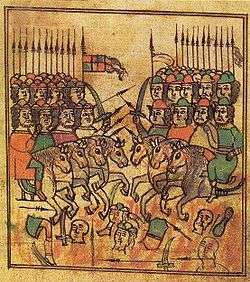 17th century illustration | |||||||
| |||||||
| Belligerents | |||||||
|
Russian principalities: |
| ||||||
| Commanders and leaders | |||||||
| Dmitri Ivanovich Donskoy of Moscow |
| ||||||
| Strength | |||||||
| from 30,000[2] to 50,000-60,000[3] | from 30,000[2] to 100,000[4] – 150,000[5] | ||||||
| Casualties and losses | |||||||
| Unknown | 8/9 of the army | ||||||
The Battle of Kulikovo (Russian: Мамаево побоище, Донское побоище, Куликовская битва, битва на Куликовом поле) was fought between the armies of the Golden Horde under the command of Mamai, and various Russian principalities under the united command of Prince Dmitri of Moscow. The battle took place on 8 September 1380, at the Kulikovo Field near the Don River (now Tula Oblast, Russia) and was won by Dmitri, who became known as Donskoy (of the Don) after the battle.
Although the victory did not end the Mongol domination over Russia, it is widely regarded by Russian historians as the turning point when Mongol influence began to wane and Muscovite power to rise. This process eventually led to Muscovite independence and formation of the modern Russian state. According to the Russian historian Lev Gumilev, "Russians went to the Kulikovo field as citizens of various principalities and returned as a united Russian nation".[6]
Background

After the Mongol-Tatar conquest, the territories of the disintegrating Kievan Rus became part of the western region of the Mongol Empire (also known as the Golden Horde), centered in the lower Volga region. The numerous Russian principalities became the Horde's tributaries. During this period, the small regional principality of Moscow was growing in power and was often challenging its neighbors over territory, including clashing with the Grand Duchy of Ryazan. The intrigues between Moscow and Ryazan pre-date the Mongol-Tartar conquest, having arisen during the ascent of regional powers within the Kievan Rus.
A civil war had arisen in the falling Golden Horde and new political powers were appearing, such as the Grand Duchy of Lithuania, the Grand Duchy of Moscow, and the Grand Duchy of Ryazan. After the mysterious death of Khan Abdulla the Tartar in 1370, warlord (temnik) Mamai took control of the Golden Horde and was appointed regent for the immature Khan Muhammad Bolak. Mamai was not a Genghisid (descendant of Genghis Khan), and as such his grip on power was tenuous, as there were blood-descendants of Genghis Khan with potential claims to the ruler-ship of the Horde. Meanwhile, the expansion of the Grand Duchy of Lithuania was gaining momentum, the Duchy having taken over some former territories of the Golden Horde and, after the Battle of Blue Waters, having secured power over both Kiev and parts of the northern Black Sea coast.
In 1362, the Prince of Moscow, Dmitri Donskoi, came into physical possession of the Grand Duchy of Vladimir. He sought a jarliq (law pronouncement) from Mamai granting him formal possession of the Duchy. Instead, in 1371, Mamai passed its title to the Prince of Tver. Prince Dmitri refused to accept Mamai's decision. Conflict ensued in 1377, when a friend of Mamai Arpash defeated the united armies of Suzdal and Moscow, led by Prince Dmitri, at the Battle of Pyana River. The victors then began to raid Nizhniy Novgorod and Ryazan.
After the victory, Mamai sought to re-affirm his control over the tributary lands of the Golden Horde. In 1378, he sent forces led by the warlord Murza Begich to ensure Prince Dmitri's obedience. The Horde's army was defeated at the Battle of the Vozha River and Murza Begich was killed. Meanwhile, another khan, Tokhtamysh, arose in Middle Asia to challenge Mamai for the throne of the Golden Horde. Although initially unsuccessful, khan Tokhtamysh slowly began to solidfy support for his challenge to the rulership of the Horde.
In 1380, against this backdrop, Mamai chose to personally lead the Horde's forces against the forces of Moscow. In preparation for the invasion, he negotiated with both Prince Jogaila of Lithuania and a Russian prince Oleg II of Ryazan, who struggled against Dmitry. The armies of Lithuania and Ryazan marched to join the Horde's army, and Mamai camped his army on the bank of the Don river, waiting for their arrival.
Prelude
Forces
While Mamai camped, Prince Dmitry mobilized his troops and allies in Kolomna to resist the invasion. The army of Moscow was joined there by armies from most of other Russian principalities, including Tver, Suzdal, Rostov, Yaroslavl, Polotsk, Murom and Beloozero. Many of participants had to break their former loyalties: army of Smolensk, formally Jogaila's vassals, joined Dmitry, as did Jogaila's brothers Andrei of Polotsk and Dmitry of Bryansk. In spite of Oleg's alliance with Mamai, a number of Ryazan boyars defected with their servants to join Dmitry (the exact number is not known, but some 70 of Ryazan boyars were listed among dead after the battle). According to Sergius of Radonezh's hagiography, Saint Sergius met Dmitri, blessed the Russian armies before the battle, and sent a group of warrior monks to accompany the combined force.
Prince Dmitri learned of the approaching armies of Lithuania and Ryazan. On 7 September 1380, Prince Dmitri's forces crossed the Don to attack, before his enemies could combine their forces.
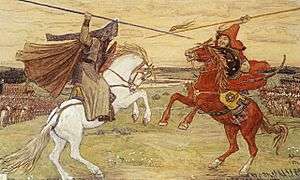
Combined Russian armies under the command of the Grand Prince of Vladimir, Dmitri Ivanovich of Moscow (called "Dmitry of the Don", in Russian "Donskoy"), faced a much larger Tatar force under the command of Mamai, a strongman of the Golden Horde. Mamai's allies, Grand Prince Oleg II of Ryazan and Grand Prince Jogaila of Lithuania, were late to the battle. According to a theory put forward by historian Dmitry Balashov, Oleg was actually not willing to join any side at all, and probably even sent some of his aforementioned "defectors" to help Dmitry, while pretending that Ryazan in general remained loyal to the Horde.
The old Russian poem Zadonshchina lists 150,000 Russians and 300,000 Tartaro-Mongols as taking part in the battle, but the actual size of the Kulikovo Field would not allow such a number of troops. The figures were more likely closer to 60,000 Russians, including 7,000 rebel Lithuanians and 125,000 Tatars. Mamai's army also included an unknown number of mercenaries he hired in a Republic of Genoa fortress Caffa (modern Feodosia, Crimea).[6]
Location
Ancient sources do not give a precise description of the site of the battle. As a result, until the 19th century the precise location of the battle was unknown until Stepan Nechaev came up with what he believed was the exact location of the battle and his hypothesis was accepted.
Battle
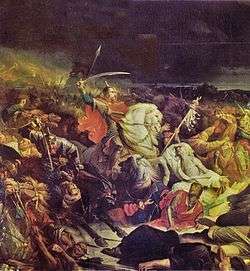
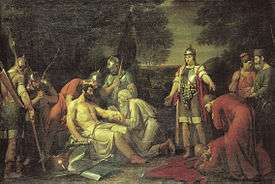
On september 7, Donskoy was told that Mamai's army is approaching. He passes the river at the Don's intersection with Nepridava and chooses a position on the fields of Kulikovo. The Grand Prince arranged his army in multiple lines. The first line was made up of elite troops (making up the vanguard of the Russian army). In the second line, the Russian center was made up of a larger force surrounded by troops that made up the left and right wings. Behind them waited the reserves. The army's flanks were covered by dense forests which destroyed any hope the horde might have had for a surprise flank attack. Under the comamand of Vladimir Andreevici Serpuhovschi and Bobroc, the russians hid another part of their army (mainly consisting of cavalry). Mamai placed his entire army on a single line. On the morning of September 8, a thick fog covered the fields of Kulikovo, preventing battle from being joined. The fog cleared around 11 a.m., and both armies began to advance.
The battle opened with single combat between two champions. The Russian champion was Alexander Peresvet, a monk from the Trinity Abbey sent to the battle by Saint Sergius. The Horde's champion was Temir-murza (also Chelubey or Cheli-bey). Though each champion killed the other during the first pass of the contest, Peresvet did not fall from the saddle, while Temir-murza did (according to Russian sources).
During the battle, Dmitri exchanged his armor with young Moscow boyarin Mikhail Brenok, in order to pretend to be an ordinary knight. Brenok was instructed to imitate the Prince, bearing his banner and wearing his armor. The trick was successful: the Tatars aimed their fire at Dmitri's banner and ultimately killed Brenok, believing he was the Prince. Dmitri himself survived, although wounded, and immediately after the battle fainted from exhaustion and loss of blood.
The Russian vanguard routed after holding the horde for some time, after which the horde advanced towards the following lines of units. After approximately three hours of battle (from noon to 3pm) the Russian forces were successful, despite great casualties, in holding off the Horde's attack. The cavalry of Vladimir, Prince of Serpukhov (Dmitri's cousin), led by Prince Bobrok (Prince Dmitri's brother-in-law), launched a surprise counterstrike on the Horde's flank, which led to the collapse of the Horde's line. After the horde was routed, the Russians chased the Tatars for over 50 kilometers, until theiy reached Mecia. All of the Khan's herds fell into the hands of Donskoy.[7]
Aftermath
Upon learning of Mamai's defeat, Prince Jogaila turned his army back to Lithuania. Prince Oleg of Ryazan was forced to accept Prince Dmitri as his sovereign and to sign a treaty of peace. Mukhammad-Bulek, Mamai's figurehead Khan, was killed in battle. Mamai escaped to the Genoese stronghold Caffa in Crimea and was soon assassinated by the mercenaries, whom he failed to pay. Mamai's rival, khan Tokhtamysh, was left in uncontested control of the Horde.
Prince Dmitri did not manage to become fully independent from the Golden Horde, however. In 1382, Khan Tokhtamysh launched another campaign against the Grand Duchy of Moscow. He captured and burned down Moscow, forcing Dmitri to accept him as sovereign. However, the victory at Kulikovo was an early sign of the decline of Mongol power. In the century that followed, Moscow's power rose, solidifying control over the other Russian principalities. Russian vassalage to the Golden Horde officially ended in 1480, a century after the battle, following the defeat of the Horde at the great stand on the Ugra River.
Legacy
The site of the battle is commemorated by a memorial church, built from a design by Aleksey Shchusev. A minor planet, 2869 Nepryadva, discovered in 1980 by Soviet astronomer Nikolai Stepanovich Chernykh, was named in honor of the Russian victory over the Tataro-Mongols.[8]
Perspectives
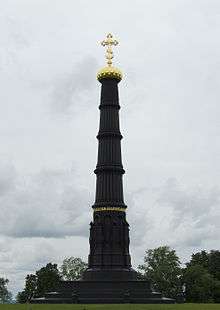
The historical evaluation of the battle has many theories as to its significance in the course of history.
- The traditional slavophile Russian point of view sees the battle as the first step in the liberation of the Russian lands from the Golden Horde dependency. It should however be noted that most parts of the old Kievan Rus at this time were controlled by the Grand Duchy of Lithuania,
- Some historians within the Eastern Orthodox tradition view the battle as a stand-off between the Christian Rus and non-Christians of the steppe.
- Russian historian Sergey Solovyov saw the battle as critical for the history of Eastern Europe in stopping another invasion from Asia, similar to the Battle of Châlons in the 5th century and the Battle of Tours in the 8th century in Western Europe.
- Other historians believe that the meaning of the battle is overstated, viewing it as nothing more than a simple regional conflict within the Golden Horde.
- Another Russian historian, Lev Gumilev, sees in Mamai a representative of economic and political interests from outside, particularly Western Europe, which in the battle were represented by numerous Genoese mercenaries, while the Moscow army stood in support of the rightful ruler of the Golden Horde Tuqtamış xan.
See also
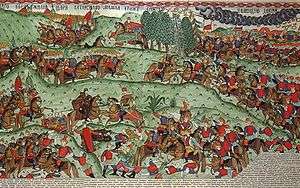
Persons
Related battles
- Battle of the Vozha River
- Great stand on the Ugra River
- Tatar invasions
- Russo-Kazan Wars
- Mongol invasion of Rus
- Timeline of the Tataro-Mongol Yoke in Russia
References
- ↑ Janet Martin, Medieval Russia 980-1584, (Cambridge University Press, 1996), 214.
- 1 2 L. Podhorodecki, Kulikowe Pole 1380, Warszawa 2008, s. 106
- ↑ Разин Е. А. История военного искусства VI — XVI вв. С.-Пб.: ООО «Издательство Полигон», 1999. — 656 с. Тираж 7000 экз. ISBN 5-89173-040-5 (VI — XVI вв.). ISBN 5-89173-038-3. (Военно-историческая библиотека)
- ↑ Карнацевич В. Л. 100 знаменитых сражений. — Харьков., 2004. - стр. 139
- ↑ Мерников А. Г., Спектор А. А. Всемирная история войн. — Минск., 2005.
- 1 2 Lev Gumilev. From Rus to Russia
- ↑ Manole Neagoe, Mari Batalii Din Istoria Lumii (Editura Scrisul Romanesc)
- ↑ Schmadel, Lutz D. (2003). Dictionary of Minor Planet Names (5th ed.). New York: Springer Verlag. p. 236. ISBN 3-540-00238-3.
External links
| Wikimedia Commons has media related to Battle of Kulikovo. |
- (Ukrainian) Unveiling the myths (Kulikovo battle)
- The Zadonshchina
- The Battle of Kulikovo
- History of Kulikovo Battle
Coordinates: 53°39.15′N 38°39.21′E / 53.65250°N 38.65350°E